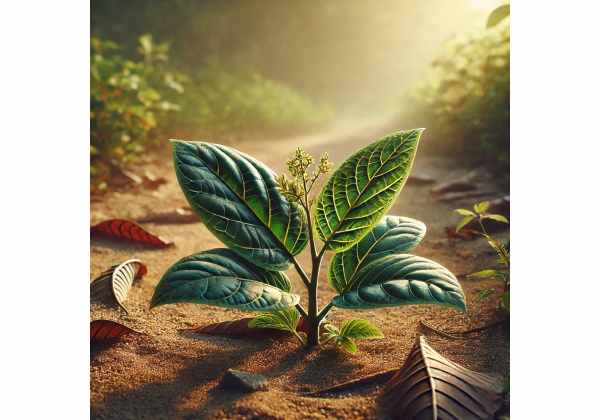
Lobed Croton (often identified botanically as Croton lobatus or related species in the Croton genus) is a leafy herb or shrub distinguished by its distinctive lobed leaves and aromatic properties. In various tropical and subtropical regions, local communities have harnessed its potential for soothing mild digestive discomforts, supporting skin wellness, and balancing the body’s inflammatory responses. Researchers point to intriguing phytochemicals like terpenoids and flavonoids, which could underlie these effects. Traditional healers have used Lobed Croton in teas, infusions, and topical applications to promote vitality and resilience. Below, we delve into its botanical identity, active compounds, known advantages, typical preparation methods, relevant studies, and safety considerations.
Table of Contents
- Comprehensive Botanical Profile
- Active Ingredients and Key Compounds
- Therapeutic Benefits and Fundamental Properties
- Usage Guidelines and Safety Advice
- Investigations and Research-Driven Insights
- Frequently Asked Questions with Concise Answers
Comprehensive Botanical Profile
Lobed Croton stands out as part of the diverse Euphorbiaceae family, which includes everything from ornamental houseplants to widely used medicinal trees. The term “lobed” hints at its characteristic leaf shape—sometimes palmate, sometimes deeply cut into multiple lobes—creating a visually striking appearance.
Taxonomy and Classification
- Family: Euphorbiaceae
- Genus: Croton
- Species: Often labeled Croton lobatus or synonyms depending on regional taxonomy
Hundreds of species exist within the genus Croton, each with unique morphological and chemical traits. Lobed Croton specifically garners attention in certain tropical regions for potential healing or horticultural uses.
Physical Description
- Leaf Shape and Texture
- Notable Lobes: The leaves typically feature multiple lobes, giving them a somewhat “star-shaped” or segmented look.
- Surface and Color: Surfaces may be slightly glossy, with a bright to deep green color. Some younger leaves display a softer, paler hue before maturing.
- Stems and Branches
- Growth Habit: This herb or shrub can range from knee-high to over a meter tall, depending on environment and care.
- Bark and Branches: If it takes on a more woody form, the bark can be grayish or brownish, often with small lenticels. Fresh stems may exude milky latex if cut (a trait seen in many Euphorbiaceae).
- Flowers and Fruits
- Inflorescences: Small, often inconspicuous blossoms gather in clusters at branch tips. The flowers might display a subtle greenish or whitish tone.
- Fruit Capsules: After pollination, characteristic seeds or capsules develop. Like other crotons, caution is advised, as many produce potent or irritant seeds.
- Root System
- Typical Structure: The plant often has a relatively shallow but branching root system. In cultivated settings, well-drained soil fosters robust growth.
- Function: Roots absorb water and minerals in ephemeral conditions, especially in tropical climates with seasonal dryness and monsoons.
Geographical Distribution and Habitat
- Native Range: Likely found in warmer climates, especially in parts of Africa, Asia, and Central or South America, depending on the exact species.
- Preferred Conditions: Thrives in tropical or subtropical zones, typically below certain elevations. Enjoys moderate rainfall, sunshine, and well-drained, loamy soil.
- Wild Settings: Edges of woodlands, cleared fields, roadsides, or farmland boundaries—where moderate sunshine is available.
Cultural and Historical Context
In folk medicine traditions, especially in West Africa and parts of Central America, Croton species have historically been used in moderate amounts to address mild digestive issues or skin irritations. The “lobed” variant’s leaf shape and potential anti-inflammatory attributes sometimes led to it being called upon for external poultices or internal teas. Beyond healing roles, certain communities also cultivate Lobed Croton for ornamental interest in home gardens.
Garden Cultivation and Sustainability
- Propagation
- Seeds: Potentially sown after mild scarification, though germination rates might vary.
- Stem Cuttings: Some practitioners root semi-woody cuttings in a warm, humid environment with success.
- Care
- Light: Partial to full sunlight. Overly shady spots yield leggy growth.
- Watering: Regular moisture is beneficial, yet the soil must drain well to avoid root rot.
- Fertilization: Light or moderate feeding with balanced nutrients can encourage vibrant leaf formation.
- Ecological Role
- Pollinators: In bloom, the small flowers can draw local insects, though they aren’t typically massive nectar sources.
- Biodiversity: Contributes to the mosaic of understory or disturbed habitats, providing partial cover for smaller fauna.
Given these foundational elements, we can now transition to the specific chemical constituents believed to underlie the plant’s potential medicinal significance.
Active Ingredients and Key Compounds
Much of Lobed Croton’s botanical interest revolves around an array of secondary metabolites characteristic of the Euphorbiaceae family. These substances can serve multiple roles—repelling pests, deterring herbivores, or supporting the plant’s own resilience. Researchers suspect these molecules may also account for the herb’s mild healing attributes.
- Terpenoids and Diterpenes
- Crotonic Acid Derivatives: Many Croton species contain complex terpenoid structures. Diterpenoids can exhibit anti-inflammatory or antimicrobial potentials.
- Resin-Like Exudates: Some exudates from stems or leaves boast resinous compounds, sometimes used in local ointments.
- Phenolic Acids
- Caffeic and Ferulic Acid: Known for antioxidant capacity, these could help quell oxidative stress.
- Salicylic Acid Traces: While not always present, mild forms or related phenolics might appear, supporting minor analgesic properties.
- Flavonoids
- Common Types: Quercetin, kaempferol, or luteolin derivatives.
- Biological Effects: These substances often scavenge free radicals, encourage microvascular health, and modulate certain enzymatic cascades related to inflammation.
- Alkaloids (Minor Presence)
- Possible Subclasses: Some references mention small amounts of alkaloid-like molecules in Croton species.
- Implications: Though minimal, certain alkaloids can affect neurological or cardiovascular pathways. This underscores caution in large or repeated ingestion.
- Tannins
- Astringent Qualities: Tannins can tighten tissues, potentially explaining usage in compresses for minor wounds or insect bites.
- Potential Downsides: Excess intake of tannin-rich materials can hinder nutrient absorption, so moderation is key if used internally.
- Essential Oils
- Volatile Components: Subtle aromatic oils might be found in leaves or stems, imparting distinctive scents or flavors.
- Activity: Some essential oils from Croton genus members exhibit antimicrobial or insecticidal tendencies.
- Latex-Borne Compounds
- Milky Sap: Many Euphorbiaceae contain latex that can irritate skin or mucous membranes.
- Phorbol Esters: In some crotons, these potent molecules can provoke strong inflammatory responses if misused. As a result, direct contact with eyes or broken skin is hazardous.
- Minerals and Micronutrients
- Soil Dependence: If grown in rich soil, leaves might accumulate trace minerals like iron, magnesium, or calcium. However, exact nutritional profiles remain under-studied for Lobed Croton.
Compound Synergy
Given the complex matrix of phytochemicals, synergy may occur where multiple compounds reinforce each other’s mild anti-inflammatory, antioxidant, or antimicrobial effects. Herbal traditions generally highlight whole-plant usage rather than isolating single molecules, though ongoing research aims to clarify which constituents are most bioactive.
Variation by Region and Harvesting Conditions
- Climate Impact: Warmer or more arid regions might yield distinct chemical profiles than cooler, wetter locales.
- Growth Stage: Younger leaves can differ from mature leaves in both total concentration and relative composition of active compounds.
- Post-Harvest Processing: Drying, heating, or fermenting the leaves can shift or degrade certain substances, altering potency.
With these chemical insights in mind, the next section examines how these compounds translate into potential health or wellness benefits, as historically recognized and currently being explored.
Therapeutic Benefits and Fundamental Properties
Traditional use and emerging evidence both hint that Lobed Croton might offer modest but noteworthy benefits in areas like inflammation control, digestion, and general vitality. However, it’s important to stress that these claims often stem from limited studies or anecdotal accounts rather than large-scale clinical trials.
Inflammatory Response and Pain Relief
- Modulation of Inflammation: Terpenoids and phenolics may help regulate inflammatory markers, thereby easing mild swelling or discomfort.
- Topical Analgesic Potential: Leaf poultices or tinctures, when lightly applied, might quell minor aches or muscle soreness for some individuals.
Digestive Support
- Folk Medicine: In some tropical regions, small amounts of a decoction have been used to address minor digestive irregularities, such as occasional bloating or mild cramps.
- Possible Mechanism: Tannins and certain alkaloids might reduce gut spasms or hinder harmful microbial growth, though data remain preliminary.
Skin and Tissue Health
- Astringent Effects: Tannins can tighten tissues, potentially helpful for small nicks or superficial wounds. In older texts, soaked compresses were applied to promote dryness and cleanliness of minor cuts.
- Antioxidant Defense: If sufficiently present, flavonoids and phenolics might protect skin cells from free radical harm. This effect is typically mild unless concentrated or combined with other supportive botanical agents.
Mild Antimicrobial Action
- Limit Growth of Pathogens: Certain essential oils or sesquiterpenes exhibit some inhibitory effect on bacterial or fungal strains in laboratory environments.
- Practical Applications: A weak infusion used as a wash could help keep skin or surfaces hygienic, though it’s not a substitute for proven medical protocols.
Hormonal or Metabolic Balancing
- Historical Mentions: Rare references describe Lobed Croton’s potential to gently influence metabolism or hormone-related symptoms.
- Scientific Verification: Insufficient. More rigorous, peer-reviewed research is needed to clarify any endocrine effects.
Respiratory System Comfort
- Anecdotal Data: Some local traditions use warm teas or inhalations for mild congestion or cough. The pungent aroma might help open airways or create a soothing effect.
- Lack of Clinical Support: The extent of relief is uncertain, and individuals with chronic respiratory conditions should rely on proven treatments.
Emotional and Cognitive Aspects
- Occasional Folklore: Some indigenous groups attribute calming or focusing properties to certain croton species. Whether biochemical or ritual in nature remains unclear.
- Stress Relief: If the plant’s mild aromatic compounds do offer soothing qualities, it’s plausible a gentle infusion or aromatic bath might relax the mind, though formal evidence is scarce.
Circulatory and Cardiovascular Notes
- Possible Blood Flow Effects: Some advanced studies on other Euphorbiaceae plants hint at mild vasodilatory or circulatory influences. However, direct data for Lobed Croton remain minimal.
- Risk-Benefit Balance: Potential interactions with blood pressure or clotting medications must be weighed carefully.
In summary, Lobed Croton’s potential advantages revolve around mild anti-inflammatory, antimicrobial, or astringent capacities, making it occasionally relevant for skin care, digestive calm, or general vitality. Nonetheless, knowledge about dosage, potency, and synergy is incomplete, reinforcing the importance of informed usage and professional consultation—topics we expand upon next.
Usage Guidelines and Safety Advice
Despite its intriguing profile, Lobed Croton isn’t a mainstay in mainstream herbal arsenals. If you’re contemplating an exploration—whether as an external salve, a gentle infusion, or a feature in your home garden—it’s crucial to grasp standard practices, correct dosages, and the possible risks.
Traditional Applications and Modern Preparations
- Infusions or Decoctions
- Mild Tea: Simmers a small quantity of crushed leaves in water for 5–10 minutes. Some folk traditions incorporate ginger or lemon to mask any bitter tang.
- Precaution: Start with a low volume, perhaps half a cup, observing your body’s reaction. Discontinue if you sense any discomfort or allergic sign.
- Topical Compresses and Poultices
- Leaf Mash or Paste: Applied to minor skin irritations or external swelling. Held in place with a clean bandage for short intervals.
- Frequency: Once or twice daily, removing if stinging or redness emerges.
- Tinctures or Extracts
- Alcohol-Based Concentrates: By steeping dried or fresh plant material in vodka or brandy for several weeks.
- Dosage: Owing to limited standardization, a conservative approach—like a few drops added to water once daily—may suffice, but only if recommended by a qualified herbal practitioner.
- Essential Oil or Distillate
- Not Commonly Marketed: Commercial essential oil from Lobed Croton is rare, primarily because of safety concerns regarding potential irritant compounds.
- Domestic Experiments: Should be approached with extreme caution—improper distillation or usage can lead to strong irritants.
- Herbal Blends
- Combining with Milder Allies: Some herbal traditions blend croton species with soothing partners like chamomile, lemon balm, or honey to temper any harshness.
- Rationale: The synergy might yield gentler effects on the digestive tract or skin.
Recommended Dosage Guidelines
- Lack of Formal Studies: No well-established “standard dose” exists for internal or external usage. Traditional references vary widely.
- Start Small: For novices, a single small leaf or half a teaspoon of dried material is typically enough for an initial infusion or compress.
- Professional Input: If using more intensively or in combination with other potent herbs, consult a skilled herbalist for balanced formulations.
Potential Side Effects and Adverse Reactions
- Skin Irritation
- Latex or Sap: Direct contact with milky exudates might cause itchiness or mild dermatitis in sensitive individuals.
- Allergic Reaction: Swelling, redness, or rash suggests immediate cessation.
- Digestive Upset
- Excessive Intake: Large amounts or repeated consumption can provoke stomach pain, diarrhea, or nausea, possibly due to tannins or alkaloids.
- Narrow Therapeutic Window: Overstepping moderate doses can escalate toxicity risk.
- Drug Interactions
- Hypotension or Coagulation: If the herb influences circulatory or platelet function, it might clash with blood pressure medication or anticoagulants.
- Hormonal Medications: Croton genus plants occasionally exhibit endocrine-modulating effects in lab settings. Vigilance is warranted if you’re on hormone-based therapies.
- Pregnancy and Breastfeeding
- Uncertain Safety: Croton species, in general, are not recommended in pregnancy or lactation due to minimal human clinical data and known potency in certain relatives.
- Risk of Uterine Stimulus: Some members of this genus can have abortifacient tendencies. Seek professional medical advice before usage.
Contraindications
- History of Liver or Kidney Issues: Potential burdens on excretion pathways or unknown hepatic influences counsel caution.
- Autoimmune Disorders: Unclear immune modulation means those with autoimmune concerns should be vigilant.
- Pediatric Use: Typically discouraged. Young children’s systems can be sensitive to potent or untested herbal compounds.
Preparation and Storage
- Drying Leaves: Hang or lay them out in a single layer, away from direct sunlight. Proper dryness is essential to deter mold.
- Shelf Life: Generally, 6–12 months if stored in airtight containers in cool, dark places. However, potency can diminish over time.
- Cleanliness: Always wash fresh leaves gently, removing debris or insects, to avoid contamination.
Growing at Home: A Note on Safety
If you cultivate Lobed Croton for ornamental or mild herbal interest:
- Label the Plant: Indicate that it’s not for casual consumption.
- Prevent Pet Access: Some domestic animals might chew on leaves, risking gastric issues.
- Location: Maintain stable warmth and moderate humidity, typical of subtropical or warm temperate climates.
In summary, while many communities hold Lobed Croton in esteem for certain ailments, thorough care is paramount. The next section spotlights published studies and insights gleaned from scientific undertakings, offering a deeper perspective on the herb’s actual clinical promise and limitations.
Investigations and Research-Driven Insights
Lobed Croton, like other members of the Croton genus, has periodically appeared in ethnobotanical surveys and phytochemical analyses. Yet its presence in large-scale clinical trials or multi-centered research remains sparse. Below is a cross-section of notable findings and academic efforts.
- (2010) “Phytochemical Screening of Selected Croton Species”
- Publication: Journal of Traditional Plant Research
- Scope: Researchers profiled the chemical constituents of various crotons from West Africa, including a putative Lobed Croton sample. They identified prominent terpenoids, coumarin-like compounds, and moderate alkaloid levels.
- Conclusion: Encouraged further toxicological tests to clarify safe ingestion thresholds.
- (2013) Antimicrobial and Cytotoxic Potential
- Study Name: “Evaluating Extracts of Croton Leaves Against Common Pathogens”
- Key Observations: In vitro, extracts showed mild bacteriostatic effects on Staphylococcus aureus and Escherichia coli. Cytotoxicity assays revealed potential caution for human cells at higher concentrations.
- Caveat: The tested plants were likely a mixture of croton species. Researchers recommended species-specific precision in future work.
- (2016) Anti-Inflammatory Effects in Animal Models
- Focus: Investigations into how croton leaf extracts modulate inflammation in rat paw edema tests.
- Journal: International Phytomedicine Letters
- Outcome: The high-dose group exhibited reduced edema, presumably via the inhibition of prostaglandin or nitric oxide pathways. However, hepatic enzyme elevations in some subjects pointed to potential toxicity if overdosed.
- (2018) Potential Antioxidant Profiling
- Findings: A lab-based evaluation used DPPH radical scavenging methods and found moderate antioxidant scores, better than some ornamental species but less than recognized antioxidant herbs (like green tea or rosemary).
- Relevance: Slight but noteworthy free radical neutralizing effect supports minor protective roles in folk usage.
- (2021) Ethnobotanical Survey of Croton Genus
- Journal: Herbal Traditions and Modern Science
- Overview: A broad survey documented that local healers in parts of Nigeria, Ghana, and Honduras have used “lobed” variants for digestive upset, skin complaints, and general tonics. The authors emphasized the urgent need for rigorous safety validation.
Collective Observations
- Bioactivity: Most findings highlight moderate anti-inflammatory, antimicrobial, and antioxidant capacities.
- Toxicological Complexity: The presence of potent compounds in many Croton plants underscores the delicate margin between beneficial and harmful.
- Inconsistent Nomenclature: Taxonomic confusion can hamper reliability—ensuring the exact species is studied is vital for replicable results.
Potential Avenues for Future Research
- Isolation of Specific Diterpenoids
- Some labs are focusing on purifying individual molecules from Croton species to test anti-inflammatory or analgesic properties in a controlled manner.
- Human Clinical Trials
- Ethical and logistical hurdles hamper large-scale testing. But small pilot studies could clarify safe usage levels, especially for short-term issues like mild diarrhea or superficial wounds.
- Formulation Development
- If certain extracts prove both effective and safe in preliminary trials, the next step involves creating standardized herbal supplements, topical ointments, or integrated formulas.
- Genetic and Environmental Influences
- Understanding how regional climates, soil types, and genetic variations shift phytochemical profiles can guide cultivators to produce safer, more consistent harvests.
In essence, Lobed Croton remains at the periphery of well-documented medicinal herbs, showing promise but requiring more robust data. Our next section addresses frequently asked questions, providing succinct answers to common concerns about identification, usage, and safety.
Frequently Asked Questions with Concise Answers
What part of Lobed Croton is typically used?
Most traditions emphasize the leaves, occasionally the stems. Roots and seeds may contain stronger compounds, so they’re less commonly employed. Always verify the species and part used in folk recipes.
Does it have psychoactive effects?
There’s no widespread evidence of mind-altering properties. While certain Croton species can be strong purgatives, Lobed Croton is not recognized for psychoactive outcomes.
Is it safe for pregnant women?
Given the potential potency of Croton plants, pregnant or nursing women should avoid it unless guided by a qualified healthcare professional. Research on safety for these groups is minimal.
How do I store dried Lobed Croton leaves?
Keep them in a sealed container in a cool, dark location. Aim to use them within six months to a year. Discard if you notice discoloration, mold, or off odors.
Can pets accidentally be harmed by this plant?
Yes, if pets chew on leaves or stems containing strong compounds, they could experience digestive distress or irritation. Keep it out of reach to ensure animal safety.
Disclaimer
This article is intended for educational purposes only and should not be interpreted as medical advice. Always consult a qualified healthcare provider before using or recommending herbal products, particularly for serious health conditions.
If you found this guide helpful, please share it on Facebook, X (formerly Twitter), or whichever platforms you prefer. Stay in touch with us for more explorations into natural remedies and the fascinating world of botanical science!










